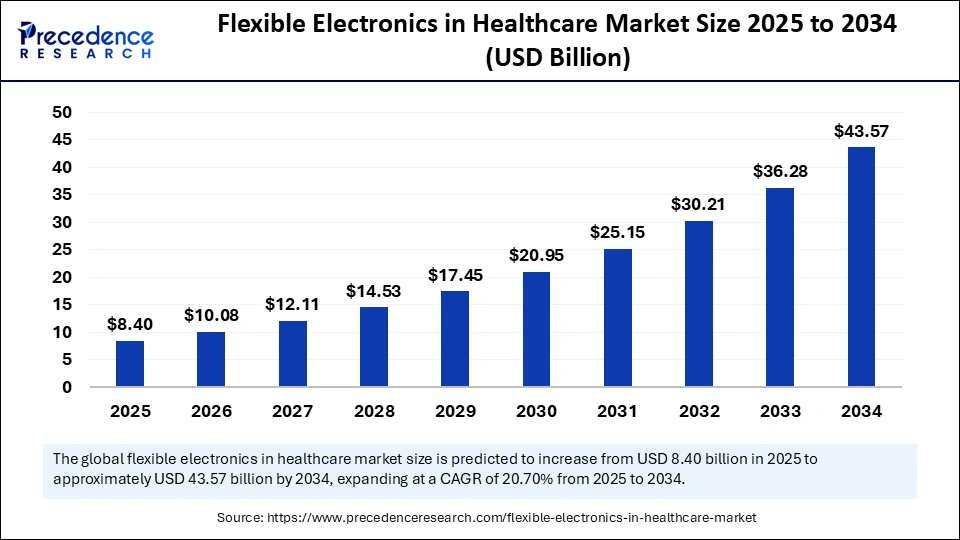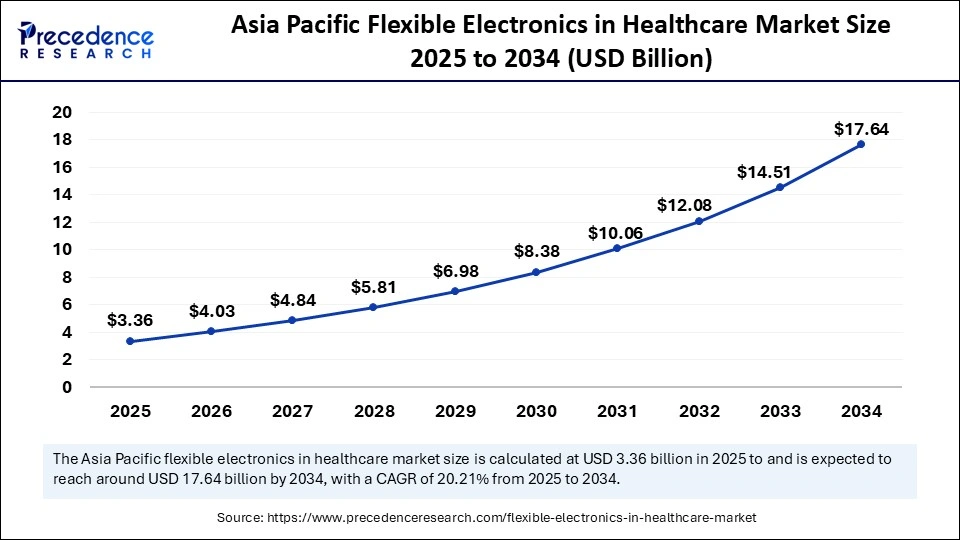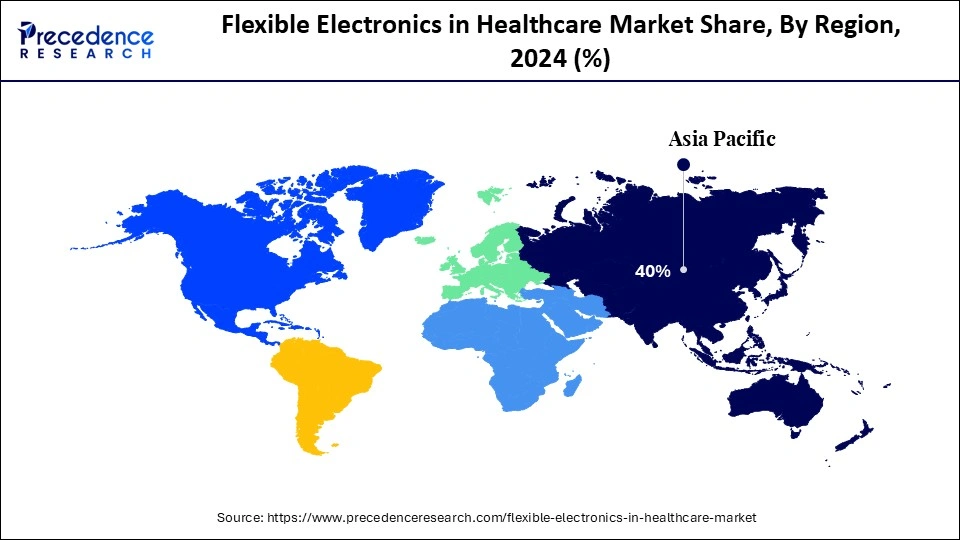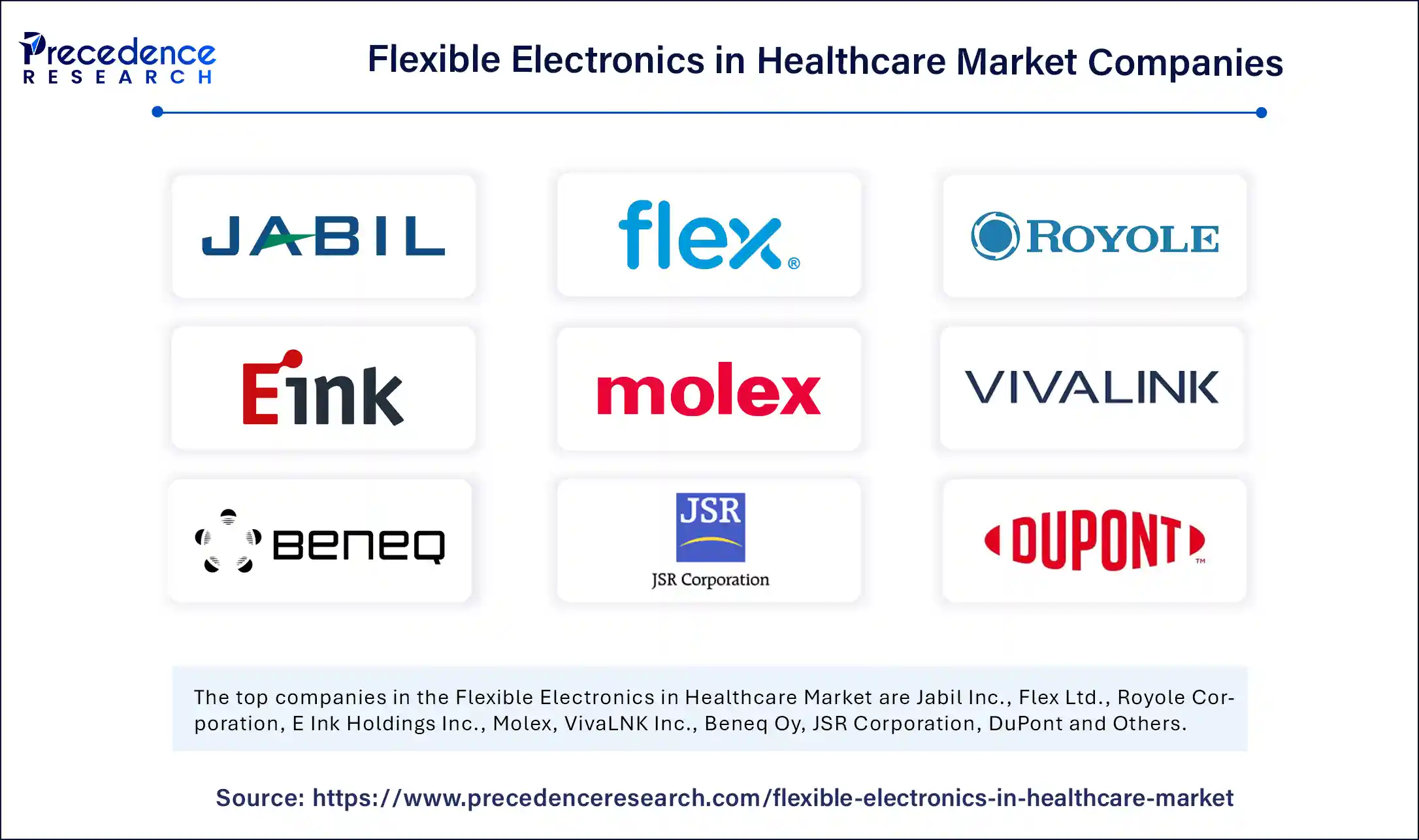List of Contents
Flexible Electronics in Healthcare Market Size and Forecast 2025 to 2034
The global flexible electronics in healthcare market size accounted for USD 7.00 billion in 2024 and is predicted to increase from USD 8.40 billion in 2025 to approximately USD 43.57 billion by 2034, expanding at a CAGR of 20.70% from 2025 to 2034. The rising prevalence of chronic diseases, growing demand for wearable health monitors, increasing consumer preference for biosensor-equipped smart clothing, and rapid technological innovation are expected to boost the growth of the global flexible electronics in healthcare market over the forecast period. Several prominent players are widely adopting effective strategies like new product launches and mergers to gain a competitive edge and strengthen their market share. Additionally, the market is expanding in emerging regions, particularly the Asia Pacific, fueled by the presence of key market players and the expansion of production & manufacturing capacity of flexible electronics.

Flexible Electronics in Healthcare Market Key Takeaways
- In terms of revenue, the global flexible electronics in healthcare market was valued at USD 7.00 billion in 2024.
- It is projected to reach USD 43.57 billion by 2034.
- The market is expected to grow at a CAGR of 20.70% from 2025 to 2034.
- Asia Pacific dominated the global flexible electronics in healthcare market with the largest share of 40% in 2024.
- North America is expected to grow at a significant CAGR from 2025 to 2034.
- By product type, the electronic skin patches/wearable skin patches segment captured the biggest market share of 34% in 2024.
- By product type, the implantable flexible bioelectronics segment is also experiencing the fastest growth during the forecast period.
- By application, the vital signs monitoring segment contributed the largest market share of 30% in 2024.
- By application, the glucose & biochemical sensing segment is anticipated to grow at the highest CAGR between 2025 and 2034.
- By technology/fabrication, the printed electronics / roll-to-roll printed sensors segment held the highest market share of 40% in 2024.
- By technology, the flexible hybrid electronics segment is expanding at a significant CAGR from 2025 to 2034.
- By end-user, the home healthcare & remote monitoring (RPM) segment generated the major market share of 38% in 2024.
- By end-user, the clinical research & pharma segment is experiencing rapid growth during the forecast period.
How Is AI Impacting the Growth of Flexible Electronics in Healthcare Market?
As AI technology continues to advance, the integration of Artificial Intelligence (AI) emerges as a driving force. It holds great potential to revolutionize the growth of the flexible electronics in the healthcare market by offering an innovative way for disease detection, diagnosis, and monitoring. AI-powered devices facilitate real-time monitoring of physiological and biochemical parameters like cardiac activity, blood pressure, and glucose levels, which allows for early disease detection, precision therapeutics, and chronic condition management. Continuous monitoring through AI-driven devices allows for early detection of potential health issues and enables proactive interventions. AI can tailor the treatment plan based on individual patient data, optimizing medication dosages and identifying potential side effects.
Asia Pacific Flexible Electronics in Healthcare Market Size and Growth 2025 to 2034
The Asia Pacific flexible electronics in healthcare market size is exhibited at USD 3.36 billion in 2025 and is projected to be worth around USD 17.64 billion by 2034, growing at a CAGR of 20.21% from 2025 to 2034.

How Did Asia Pacific Lead the Flexible Electronics in Healthcare Market in 2024?
Asia Pacific held the dominant share of the flexible electronics in healthcare market in 2024. The region benefits from supportive healthcare regulations, a rise in healthcare expenditure, a surge in the aging population, rapid technological progress, and increasing demand for non-invasive wearable devices. The region is experiencing rising demand from home healthcare & remote monitoring (RPM) settings, as flexible electronics provide valuable data for rapid diagnosis, effective preventive care, and personalized management of chronic conditions. The increasing rates of chronic diseases such as heart disease, hypertension, diabetes, and asthma have led to an increase in the need for continuous, real-time monitoring of vital signs and critical physiological data, which further boosts the demand for flexible electronics in the region. Moreover, the key players are heavily investing in research and development into designing innovative flexible electronics, accelerating the market's expansion in the region.
According to the article published by the Press Information Bureau (PIB) in January 2025, in an event held at NIT Warangal, silver nanowire-based conductive ink technology was transferred to two startups. The startups are M/s Chematico Technologies Private Limited (incubated at IIT Ropar) and M/s Vasanthbala Functional Materials Pvt Ltd (incubated at NIT Warangal). The technology was developed under a project funded by the Ministry of Electronics and Information Technology (MeitY). Technology used in flexible electronics, wearable devices, sensors, and solar panels to advance self-reliance and reduce import dependency.
(Source: https://www.pib.gov.in)

What Made North America the Fastest-Growing Region in the Flexible Electronics in Healthcare Market in 2024?
North America is expected to grow at the fastest rate in the market during the forecast period. The fastest growth of the region is supported by its advanced healthcare infrastructure, increasing need for real-time monitoring of vital signs, increasing presence of key market players, high per capita expenditure on healthcare, and ongoing innovation in flexible electronics devices. The growing popularity of personalized healthcare solutions and remote healthcare services enables continuous monitoring of critical biosignals for preventive care and disease diagnosis. The United States is a major contributor to the market in the North American region, driven by supportive regulatory frameworks, extensive R&D investment, high adoption of wearable health technologies, and rising collaborations among tech companies, medical institutions, and government agencies.
Market Overview
The flexible electronics in healthcare market deals with the fabrication and distribution of electronic devices and systems built on bendable, stretchable, or conformable substrates (polymers, foils, textiles) that enable wearable, patchable, implantable, or textile-integrated medical devices. Key products include electronic skin patches (e-patches) for continuous physiological monitoring, flexible printed sensors, e-textiles, stretchable bioelectrodes, conformal implantables, and flexible power/energy modules. These combine flexible materials, printed/flexible sensors, flexible interconnects, low-power electronics (flexible hybrid electronics — FHE), wireless connectivity, and software/analytics to deliver ambulatory monitoring, diagnostic, therapeutic, and drug-delivery functions with comfort and improved patient compliance.
What Are the Key Trends in the Flexible Electronics in Healthcare Market?
- The rising trend towards digitization in healthcare, which drives the demand for electronic skin patches, e-textiles, flexible printed sensors, and test strips, accelerates the market's growth during the forecast period.
- The increasing consumer preference for lightweight, flexible, and comfortable devices for health monitoring is expected to propel the growth of the flexible electronics in healthcare market during the forecast period.
- The increasing need for continuous and non-invasive health tracking, especially for managing chronic conditions such as glucose levels, blood pressure, ECG traces, heart rates, respiratory rates, and others, is expected to propel the growth of the market during the forecast period.
- The rising adoption of IoT in healthcare spurs the demand for flexible sensors and devices are anticipated to contribute to the overall growth of the flexible electronics in healthcare market.
- The rise in healthcare spending and rising inclination towards data-driven approaches in healthcare are anticipated to boost the expansion of flexible electronics in the healthcare market.
- The surge in the aging population around the world is anticipated to fuel the market's growth during the forecast period.
Market Scope
| Report Coverage | Details |
| Market Size by 2034 | USD 43.57 Billion |
| Market Size in 2025 | USD 8.40 Billion |
| Market Size in 2024 | USD 7.00 Billion |
| Market Growth Rate from 2025 to 2034 | CAGR of 20.70% |
| Dominating Region | Asia Pacific |
| Fastest Growing Region | North America |
| Base Year | 2024 |
| Forecast Period | 2025 to 2034 |
| Segments Covered | Product Type, Application / Use Case, Technology / Fabrication, End-User / Healthcare Setting, and Region |
| Regions Covered | North America, Europe, Asia-Pacific, Latin America, and Middle East & Africa |
Market Dynamics
Drivers
Growing Demand for Wearable Devices
The rising demand for wearable devices is expected to boost the growth of flexible electronics in the healthcare market during the forecast period. Wearable Devices such as electronic skin patches, electrochemical test strips, stretchable bioelectrodes, and smart clothing (e-textiles) are increasingly being adopted for continuous, real-time health tracking and monitoring. The user-friendliness and comfort of flexible electronic devices significantly increase the adoption among patients, leading to better outcomes. Flexible sensors are lightweight, flexible, and conform to the skin without causing and irritation. These wearable sensors offer continuous and non-invasive monitoring of signals such as blood pressure, pulse, respiration, and SpOâ‚‚. Moreover, the integration of therapeutic and sensing capabilities enables personalized and long-term treatment for various chronic health conditions, bolstering the market's growth during the forecast period.
Restraint
High Cost of Device Manufacturing and Safety Risks
The high cost of manufacturing flexible electronics is one of the primary restraints impacting market expansion. Developing these devices requires substantial upfront investment in research, design, and production. Manufacturers must rely on advanced technologies such as thin-film transistors, organic semiconductors, and nanomaterials, all of which are expensive to source and integrate. Additionally, the fabrication process demands highly specialized equipment and complex procedures, driving up capital expenditure and operational costs. Small and mid-sized healthcare device manufacturers, in particular, may struggle to bear these financial burdens, creating barriers to entry and slowing overall market adoption.
Beyond cost, safety concerns also remain a major restraint to growth. Flexible bioelectronics used in healthcare applications are expected to maintain a certain standard of performance under repeated bending, stretching, and prolonged contact with the human body. Issues such as material degradation, potential toxicity of certain nanomaterials, and risks of device malfunction can raise serious safety concerns and, in turn, regulatory hurdles that limit widespread clinical acceptance. Ensuring biocompatibility, durability, and reliability adds another layer of expense incurred during the design and testing stages. As a result, both the high manufacturing costs and unresolved safety concerns are expected to act as significant constraints for the growth of the global flexible electronics in healthcare market during the forecast period.
Opportunity
How Is the Growing Popularity of Telemedicine and Remote Healthcare Services Impacting the Market Expansion?
The telemedicine and the increasing demand for remote healthcare services are projected to offer lucrative growth opportunities to the flexible electronics in healthcare market during the forecast period. Flexible electronics are well-suited and widely used in telemedicine through wearable sensors, e-textiles, and electronic skin patches. Flexible electronics provide continuous monitoring and personalized care in remote healthcare, which is crucial for effectively managing chronic conditions and reducing the need for hospital admission. Therefore, the market is experiencing the rising expansion of telemedicine and remote healthcare services, accelerating the adoption of flexible electronics for remote patient monitoring and diagnostics.
Product Type Insights
What Made the Electronic Skin Patches Segment Lead the Flexible Electronics in Healthcare Market in 2024?
The electronic skin patches segment dominated the market in 2024, owing to the increasing demand for a non-invasive and comfortable approach to monitoring vital signs and other physiological parameters. Electronic skin patches are flexible, thin, and stretchable devices designed to adhere directly to the skin. The increasing incidence of chronic health conditions globally has propelled the demand for these electronic skin patches. In June 2024, A team of researchers from the University of Chicago, Bozhi Tian, and Columbia University designed a novel bioelectronic patch that could be used to help monitor and treat chronic skin conditions. This device integrates advanced electronics, living cells, and hydrogel, and has shown promising results in mouse experiments.(Source: https://www.azosensors.com)
On the other hand, the implantable flexible electronics segment is witnessing the fastest growth. Implantable flexible electronics are electronics designed to be implanted inside the body, made with soft and flexible materials, and can conform to the body's tissues. Implantable flexible electronics represent a significant advancement in biomedical engineering. These devices are longer-lived and suitable for permanent applications such as defibrillators, pacemakers, and neural implants for chronic conditions, continuously monitor and regulate functions in disordered organs, ultimately improving patient quality of life. Thus, bolstering the segment's expansion in the coming years.
Application / Use Case Insights
What Made the Vital Signs Monitoring Segment Lead the Flexible Electronics in Healthcare Market in 2024?
The vital signs monitoring segment was dominant, with the biggest share of the global flexible electronics in healthcare market in 2024. Flexible electronics are increasingly adopted to detect a wide range of biophysical and biochemical signals, such as heart rate, respiration, blood pressure, temperature, SpOâ‚‚, and others. Flexible electronics in vital signs monitoring offer various benefits such as non-invasive & continuous monitoring, enhanced patient comfort, and real-time data for early detection. The data collected by flexible devices can provide crucial information on factors influencing metabolic health, such as stress, unhealthy lifestyle, or poor food intake, and offer personalized recommendations. On the other hand, the glucose & biochemical sensing segment is also experiencing the fastest growth. The surge in the diabetic population has led to an increasing need for flexible electronics that allow for continuous and real-time monitoring of glucose levels, providing valuable data for effectively managing diabetes. Flexible electronics are widely various to detect various biochemical signals and metabolites in the body, offering valuable insights into overall health.
Technology / Fabrication Insights
How Printed Electronics / Roll-to-Roll Printed Sensors Segment Dominate the Flexible Electronics Market in 2024?
The printed electronics / roll-to-roll printed sensors segment held the largest segment of the flexible electronics in healthcare market in 2024, owing to the growing demand for flexible, lightweight, and cost-effective electronic devices. Printed electronics / roll-to-roll printed sensors assist in monitoring vital signs, which leads to improved patient outcomes. This technology marks a significant shift towards personalized and real-time home-based health monitoring.
On the other hand, the flexible hybrid electronics segment is expected to grow significantly in the coming years. The rapid growth of the segment is mainly attributed to the rising demand for lightweight, flexible, and high-performance electronics in the healthcare industry. Flexible hybrid electronics allow personalized patient care through advanced devices that are lightweight, comfortable, and can conform to the patient's body's intricate surfaces, providing critical real-time data for applications ranging from diabetes management to cardiovascular monitoring and wound healing.
How Did the Home Healthcare & Remote Monitoring (RPM) Segment Dominate the Flexible Electronics in Healthcare Market in 2024?
The home healthcare & remote monitoring (RPM) segment dominated the market in 2024. Flexible electronics allow providers to monitor and analyze their chronic conditions from outside the hospital setting. These devices provide real-time understanding of a patient's disease state, allowing providers to make proactive clinical decisions. Flexible sensors assist in effectively managing chronic diseases by monitoring vital signs and critical physiological data for conditions such as heart disease, hypertension, diabetes, and asthma in home healthcare & remote monitoring (RPM) settings. Moreover, patients recovering at home are widely utilising these flexible devices to monitor recovery progress after surgery, which reduces the need for in-person check-ups and hospital readmissions.
On the other hand, the clinical research & pharma segment is expected to register the fastest growth. The market is witnessing an increase in investment in flexible electronics for customization to interact with specific biological tissues and organs, paving the way for personalized diagnostic tools and advanced drug delivery systems. Flexible electronics significantly enhance clinical research and the pharmaceutical industry through wearable biosensors for continuous patient monitoring, implantable devices for long-term treatment, and various other applications. These technologies improve data accuracy, provide patient comfort, and enable innovative diagnostic and therapeutic approaches.
Flexible Electronics in Healthcare Market Companies

- Jabil Inc.
- Flex Ltd
- Royole Corporation
- E Ink Holdings Inc.
- Molex
- VivaLNK Inc.
- Beneq Oy
- JSR Corporation
- DuPont
- 3M Company
- Bebop Sensors, Inc.
- SensingTex
- Abbott Laboratories
- Samsung Display
- Nissha Co., Ltd.
- Jabil Healthcare
- Rotex
- Recent Developments
Industry Leader Announcements
- In March 2025, Naxnova Technologies announced the launch of India's first Flexible Hybrid Printed Electronics Research & Development Centre, marking a transformative moment for the country's innovation landscape. Naxnova is poised to revolutionize industries by developing next-generation smart sensors, flexible circuits, and intelligent interfaces. This pioneering initiative will drive breakthrough advancements across medical wearables, robotics, industrials, aerospace, automotive, and consumer electronics sectors.(Source: https://www.thehindu.com)
Recent Developments
- In April 2024, Epicore Biosystems, a digital health company developing advanced sweat-sensing wearables to provide real-time personalized hydration insights for performance and safety, launched Connected Hydration. Connected Hydration is the first sweat-sensing wearable patch and mobile app that equips workers with customized, real-time insights about sweat volume loss, electrolyte loss, body temperature, and body movement to inform their hydration needs ahead of adverse dehydration events.(Source: https://www.prnewswire.com)
- In November 2024, Henkel and Linxens announced a collaboration to drive the integration of advanced technologies for medical wearables based on printed electronics. As part of the collaboration, the companies have developed a proof of concept to integrate heating elements into medical wearable devices, which significantly enhances the comfort for patients(Source: https://www.electronicsmedia.info)
Segments Covered in the Report
By Product Type
- Electronic skin patches / wearable skin patches
- Flexible printed sensors
- E-textiles / smart garments
- Stretchable bioelectrodes & conformal electrodes
- Implantable flexible bioelectronics
- Flexible power & energy modules
- Flexible displays & indicators for medical wearables
By Application / Use Case
- Vital signs monitoring
- ECG / cardiac monitoring & arrhythmia detection
- Glucose & biochemical sensing
- Wound care & smart bandages
- Drug delivery patches
- Rehabilitation & motion/physiotherapy monitoring
- Neuromodulation & implantable therapy
- Remote patient monitoring (RPM) & telehealth integration
- Clinical trials wearable sensors & digital biomarkers
By Technology / Fabrication
- Printed electronics/inkjet/screen printing / roll-to-roll printed sensors
- Flexible hybrid electronics
- Stretchable materials & serpentine interconnects
- Thin-film deposition & vacuum processes
- Textile integration
- Biocompatible encapsulation/adhesives & medical adhesives
By End-User / Healthcare Setting
- Hospitals & clinical settings
- Home healthcare & remote monitoring (RPM)
- Ambulatory care / clinics
- Long-term care & eldercare facilities
- Sports medicine / wellness & consumer health
- Clinical research & pharma
By Region
- North America
- Europe
- Asia Pacific
- Latin America
- Middle East and Africa
For inquiries regarding discounts, bulk purchases, or customization requests, please contact us at sales@precedenceresearch.com
Frequently Asked Questions
Ask For Sample
No cookie-cutter, only authentic analysis – take the 1st step to become a Precedence Research client